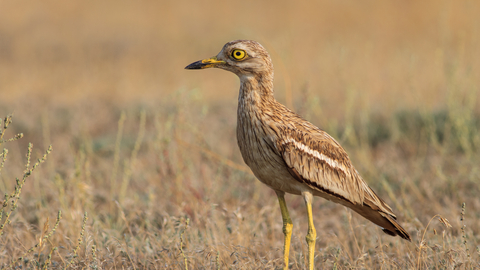
Stone curlew
Stone curlew
Scientific name: Burhinus oedicnemus
Stone curlews are unusual waders with large yellow eyes - perfect for hunting beetles at night.
Species information
Category
Statistics
Length: 38-45cmConservation status
Classified in the UK as Amber under the Birds of Conservation Concern 5: the Red List for Birds (2021). Protected in the UK under the Wildlife and Countryside Act, 1981.
When to see
March-OctoberAbout
Stone curlews are unusual for wading birds, as you're most likely to find them on dry, stony ground. They're spring and summer visitors to the UK, where they nest on sandy heaths, well-grazed grassland, and arable fields. They spend the winter in southern Europe and northern Africa, with British birds recorded as far south as Sierra Leone.They nest on the ground, relying on their camouflage to keep them safe. They can spend most of the day sitting still, making them very hard to spot. They become more active at dusk, when their large eyes help them hunt beetles, worms, and other invertebrates even in low light.
Stone curlews declined dramatically until there were only around 150 pairs remaining in the 1980s. The decline was linked to the loss of habitat, as well as changes in farming techniques that led to the well-hidden nests being accidentally destroyed by machinery. They're still rare, but the population is recovering thanks to dedicated conservation work. Conservationists are creating ideal habitat for nesting stone curlews, as well as working with farmers to find and mark nests on arable fields.
